合格させるMicrosoft AZ-104テスト問題でテストエンジンとPDFを提供中
あなたをお手軽にAZ-104試験合格させるリアルAZ-104練習問題集で更新されたのは2022年04月16日
質問 97
You have an Azure virtual network named VNet1 that connects to your on-premises network by using a site-to-site VPN. VMet1 contains one subnet named Subnet1.
Subnet1 is associated to a network security group (NSG) named NSG1. Subnet1 contains a basic internal load balancer named ILB1. ILB1 has three Azure virtual machines in the backend pool.
You need to collect data about the IP addresses that connects to ILB1. You must be able to run interactive queries from the Azure portal against the collected data.
What should you do? To answer, select the appropriate options in the answer area.
NOTE: Each correct selection is worth one point.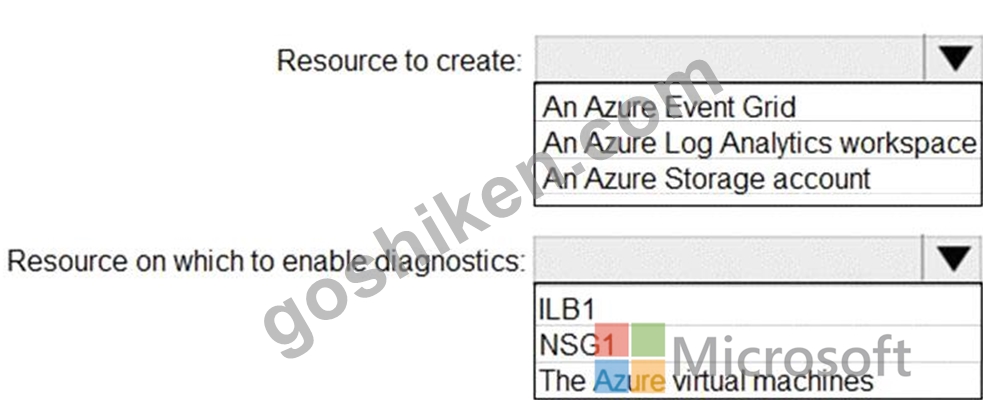
正解:
解説: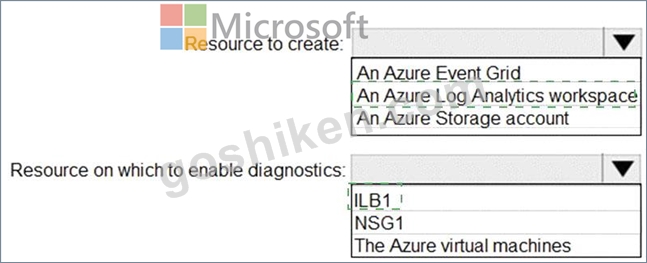
Explanation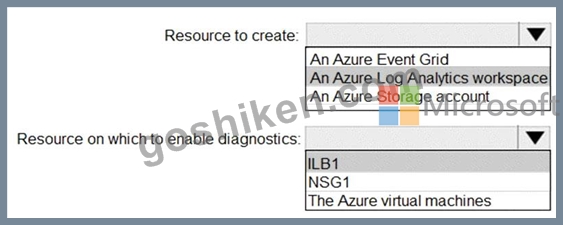
Box 1: An Azure Log Analytics workspace
In the Azure portal you can set up a Log Analytics workspace, which is a unique Log Analytics environment with its own data repository, data sources, and solutions Box 2: ILB1 References:
https://docs.microsoft.com/en-us/azure/log-analytics/log-analytics-quick-create-workspace
https://docs.microsoft.com/en-us/azure/load-balancer/load-balancer-standard-diagnostics
質問 98
You need to identify the storage requirements for Contoso.
For each of the following statements, select Yes if the statement is true. Otherwise, select No.
NOTE: Each correct selection is worth one point.
正解:
解説:
Reference:
https://docs.microsoft.com/en-us/azure/machine-learning/team-data-science-process/move-data-to-azure-blob-using-azure-storage-explorer
https://docs.microsoft.com/en-us/azure/storage/tables/table-storage-overview
https://www.serverless360.com/blog/azure-blob-storage-vs-file-storage
質問 99
You have an Azure web app named WebApp1.
You need to provide developers with a copy of WebApp1 that they can modify without affecting the production WebApp1. When the developers finish testing their changes, you must be able to switch the current line version of WebApp1 to the new version.
Which command should you run prepare the environment? To answer, select the appropriate options in the answer area.
NOTE: Each correct selection is worth one point.
正解:
解説:
Reference:
https://docs.microsoft.com/en-us/powershell/module/azurerm.websites/new-azurermwebappslot
質問 100
You have an Azure subscription that contains the Azure virtual machines shown in the following table.
You configure the network interfaces of the virtual machines to use the settings shown in the following table
From the settings of VNET1, you configure the DNS servers shown in the following exhibit.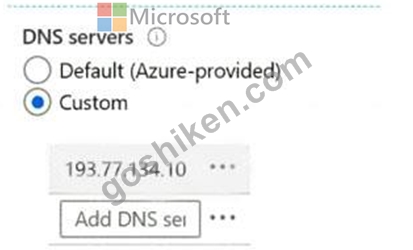
The virtual machines can successfully connect to the DNS server that has an IP address of 192.168.10.15 and the DNS server that has an IP address of 193.77.134.10.
For each of the following statements, select Yes if the statement is true. Otherwise, select No.
正解:
解説:
Explanation
Box 1: Yes
You can specify DNS server IP addresses in the VNet settings. The setting is applied as the default DNS server(s) for all VMs in the VNet.
Box 2: No
You can set DNS servers per VM or cloud service to override the default network settings.
Box 3: Yes
You can set DNS servers per VM or cloud service to override the default network settings.
Reference:
https://docs.microsoft.com/en-us/azure/virtual-network/virtual-networks-faq#name-resolution-dns
質問 101
You have an Azure subscription named Subscription1.
Subscription1 contains the virtual machines in the following table.
Subscription1 contains a virtual network named VNet1 that has the subnets in the following table.
VM3 has a network adapter named NIC3. IP forwarding is enabled on NIC3. Routing is enabled on VM3.
You create a route table named RT1. RT1 is associated to Subnet1 and Subnet2 and contains the routes in the following table.
You apply RT1 to Subnet1.
For each of the following statements, select Yes if the statement is true. Otherwise, select No.
NOTE: Each correct selection is worth one point.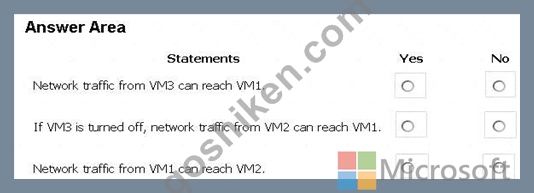
正解:
解説: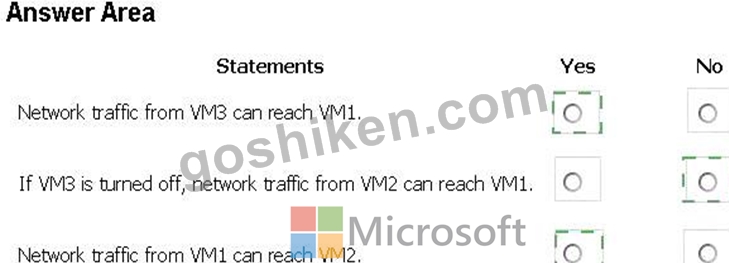
Explanation
Box 1: Yes
Traffic from VM1 and VM2 can reach VM3 thanks to the routing table, and as IP forwarding is enabled on VM3, traffic from VM3 can reach VM1.
Box 2: No
VM3, which has IP forwarding, must be turned on, in order for traffic from VM2 to reach VM1.
Box 3: Yes
The traffic from VM1 will reach VM3, which thanks to IP forwarding, will send the traffic to VM2.
Reference:
https://docs.microsoft.com/en-us/azure/virtual-network/virtual-networks-udr-overview
質問 102
HOTSPOT
You have an on-premises data center and an Azure subscription. The data center contains two VPN devices.
The subscription contains an Azure virtual network named VNet1. VNet1 contains a gateway subnet.
You need to create a site-to-site VPN. The solution must ensure that if a single instance of an Azure VPN gateway fails, or a single on-premises VPN device fails, the failure will not cause an interruption that is longer than two minutes.
What is the minimum number of public IP addresses, virtual network gateways, and local network gateways required in Azure? To answer, select the appropriate options in the answer area.
NOTE: Each correct selection is worth one point.
Hot Area: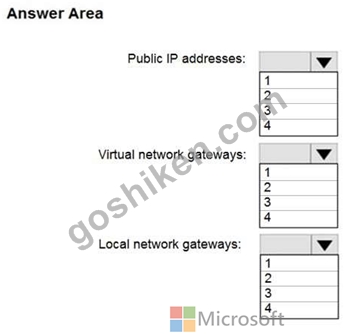
正解:
解説: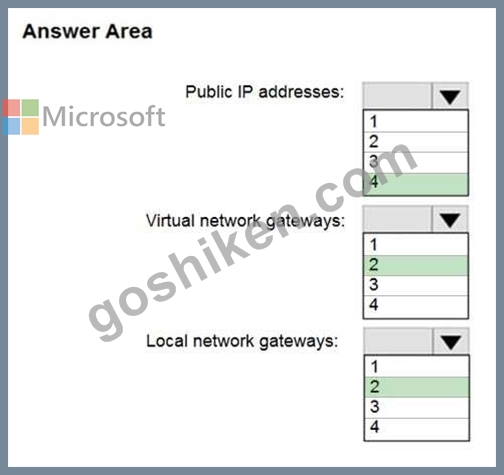
Section: [none]
Explanation:
Box 1: 4
Two public IP addresses in the on-premises data center, and two public IP addresses in the VNET.
The most reliable option is to combine the active-active gateways on both your network and Azure, as shown in the diagram below.
Box 2: 2
Every Azure VPN gateway consists of two instances in an active-standby configuration. For any planned maintenance or unplanned disruption that happens to the active instance, the standby instance would take over (failover) automatically, and resume the S2S VPN or VNet-to-VNet connections.
Box 3: 2
Dual-redundancy: active-active VPN gateways for both Azure and on-premises networks Reference:
https://docs.microsoft.com/en-us/azure/vpn-gateway/vpn-gateway-highlyavailable
質問 103
You have an Azure virtual machine named VM1 and a Recovery Services vault named Vault1.
You create a backup Policy1 as shown in the exhibit. (Click the Exhibit tab.)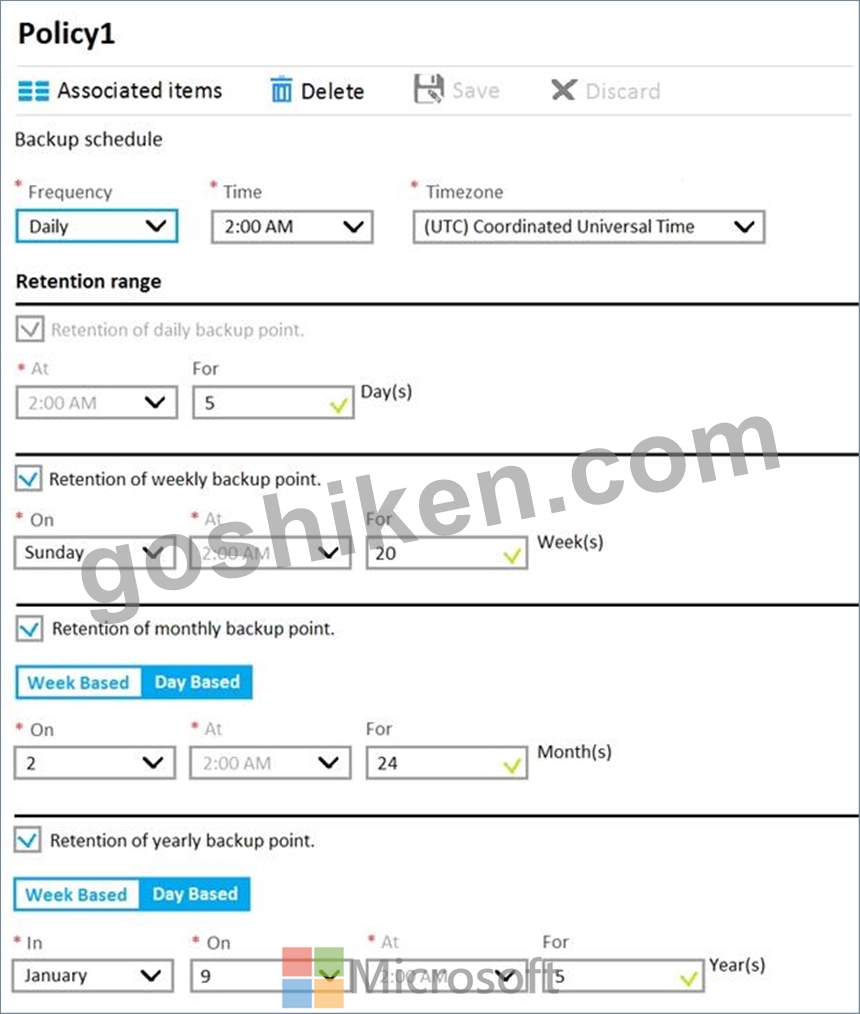
You configure the backup of VM1 to use Policy1 on Thursday, January 1.
You need to identify the number of available recovery points for VM1.
How many recovery points are available on January 8 and on January 15? To answer, select the appropriate options in the answer area.
NOTE: Each correct selection is worth one point.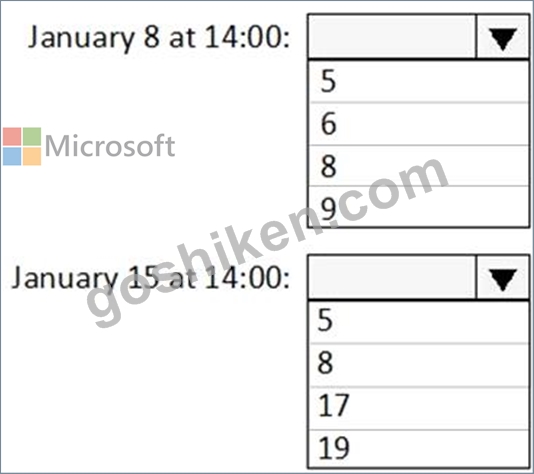
正解:
解説: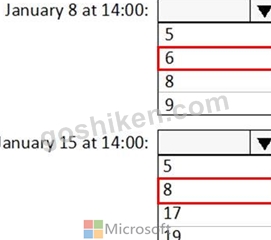
Explanation:
Box 1: 6
4 daily + 1 weekly + monthly
Box 2: 8
4 daily + 2 weekly + monthly + yearly
質問 104
You have an Azure subscription that contains an Azure file share.
You have an on-premises server named Server1 that runs Windows Server 2016.
You plan to set up Azure File Sync between Server1 and the Azure file share.
You need to prepare the subscription for the planned Azure File Sync.
Which two actions should you perform in the Azure subscription? To answer, drag the appropriate actions to the correct targets. Each action may be used once, more than once, or not at all. You may need to drag the split bar between panes or scroll to view content.
正解:
解説: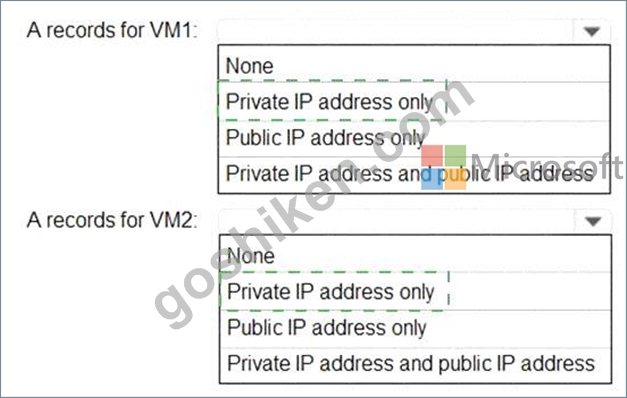
Explanation
As per the official MS doc:
The recommended steps to onboard on Azure File Sync for the first with zero downtime while preserving full file fidelity and access control list (ACL) are as follows:
1. Deploy a Storage Sync Service. --> This needs to be done on Azure .
2. Create a sync group. --> This needs to be done on Azure
3. Install Azure File Sync agent on the server with the full data set. --> This needs to be done on server1.
4. Register that server and create a server endpoint on the share. --> This needs to be done on server1.
5. Let sync do the full upload to the Azure file share (cloud endpoint).
6. After the initial upload is complete, install Azure File Sync agent on each of the remaining servers.
7. Create new file shares on each of the remaining servers.
8. Create server endpoints on new file shares with cloud tiering policy, if desired. (This step requires additional storage to be available for the initial setup.)
9. Let Azure File Sync agent do a rapid restore of the full namespace without the actual data transfer. After the full namespace sync, sync engine will fill the local disk space based on the cloud tiering policy for the server endpoint.
10. Ensure sync completes and test your topology as desired.
11. Redirect users and applications to this new share.
12. You can optionally delete any duplicate shares on the servers.
First action: Create a Storage Sync Service
The deployment of Azure File Sync starts with placing a Storage Sync Service resource into a resource group of your selected subscription.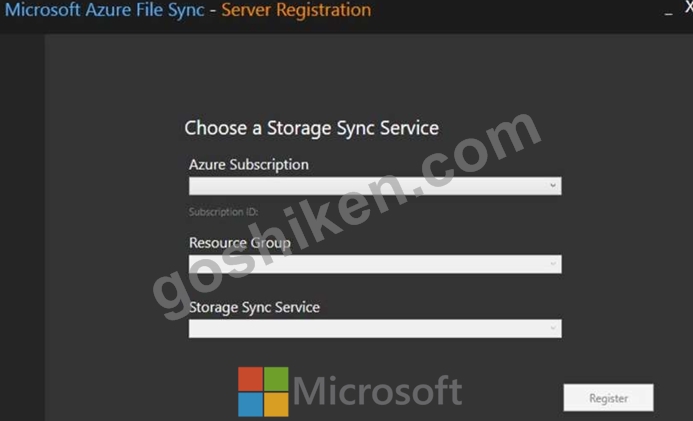
Second action: Create a sync group
A sync group defines the sync topology for a set of files. Endpoints within a sync group are kept in sync with each other. A sync group must contain one cloud endpoint, which represents an Azure file share and one or more server endpoints. A server endpoint represents a path on a registered server. A server can have server endpoints in multiple sync groups. You can create as many sync groups as you need to appropriately describe your desired sync topology.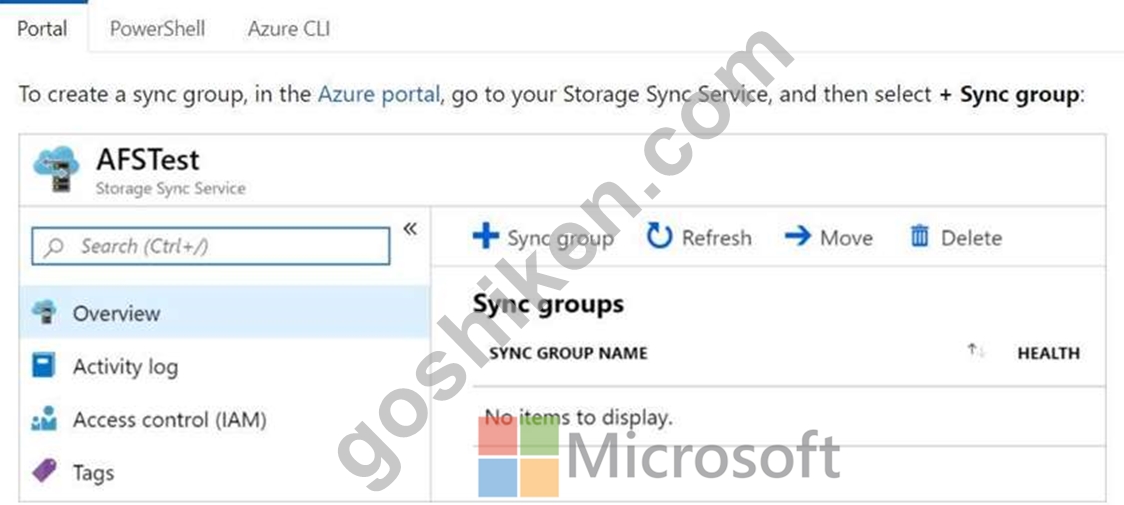
Third action: Run Server Registration
Registering your Windows Server with a Storage Sync Service establishes a trust relationship between your server (or cluster) and the Storage Sync Service. A server can only be registered to one Storage Sync Service and can sync with other servers and Azure file shares associated with the same Storage Sync Service. ) Reference:
https://docs.microsoft.com/en-us/azure/storage/files/storage-sync-files-deployment-guide?tabs=azure-portal
質問 105
You have an Azure subscription that contains a virtual machine scale set. The scale set contains four instances that have the following configurations:
* Operating system: Windows Server 2016
* Size: Standard_D1_v2
You run the get-azvmss cmdlet as shown in the following exhibit: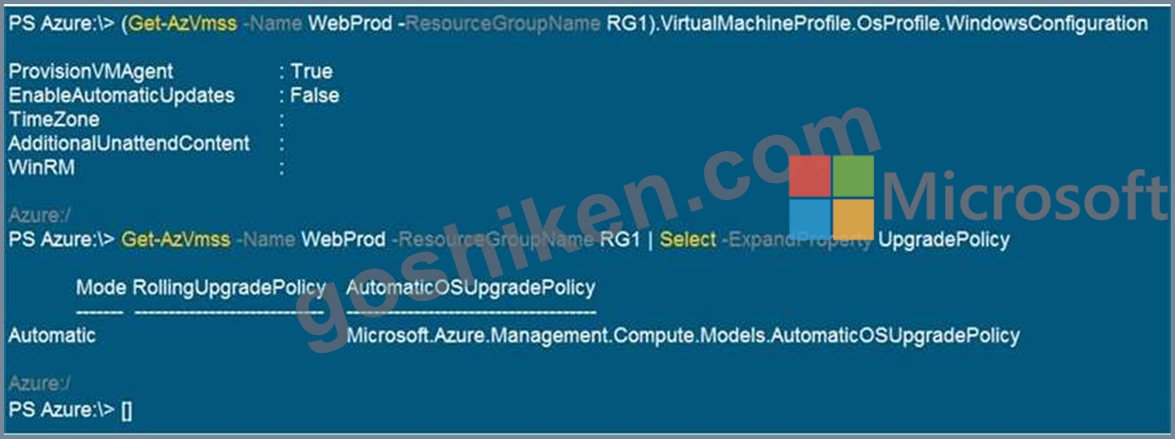
Use the drop-down menus to select the answer choice that completes each statement based on the information presented in the graphic.
NOTE: Each correct selection is worth one point.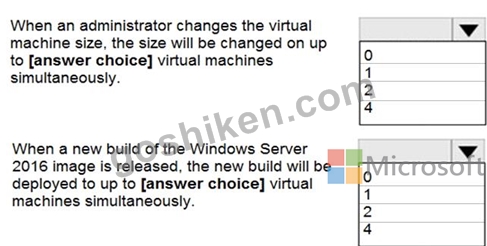
正解:
解説: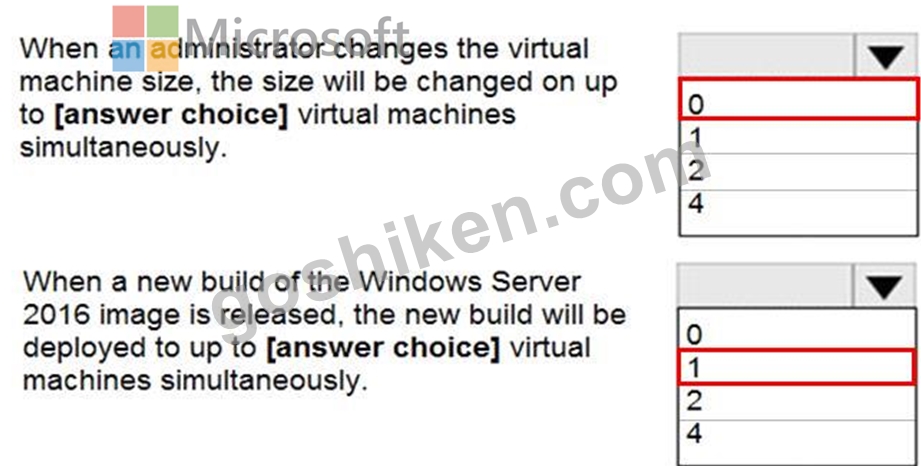
Explanation:
he Get-AzVmssVM cmdlet gets the model view and instance view of a Virtual Machine Scale Set (VMSS) virtual machine.
Box 1: 0
The enableAutomaticUpdates parameter is set to false. To update existing VMs, you must do a manual upgrade of each existing VM.
Box 2: 1
Below is clearly mentioned in the official Website
"The upgrade orchestrator identifies the batch of VM instances to upgrade, with any one batch having a maximum of 20% of the total instance count, subject to a minimum batch size of one virtual machine." So, 20% from 4 ~1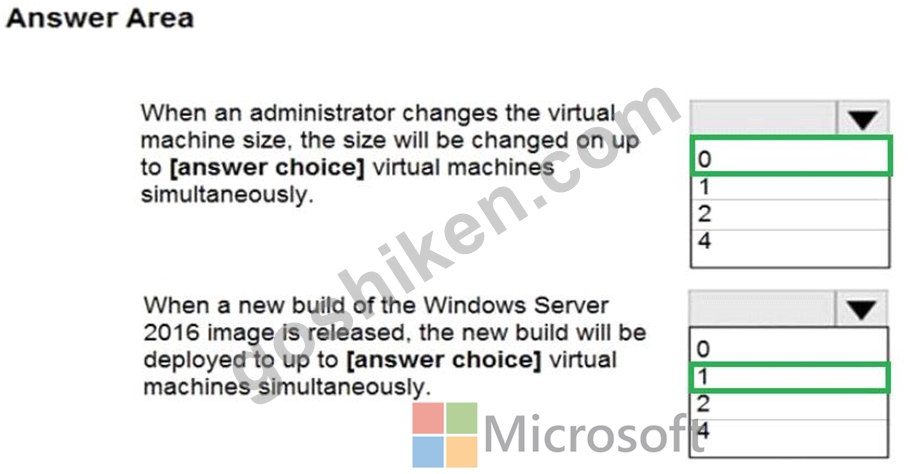
Reference:
https://docs.microsoft.com/en-us/azure/virtual-machine-scale-sets/virtual-machine-scale-sets-upgrade-scale-set
https://docs.microsoft.com/en-us/azure/virtual-machine-scale-sets/virtual-machine-scale-sets-automatic-upgrade
質問 106
Case Study 4 - ADatum
Overview
ADatum Corporation is a financial company that has two main offices in New York and Los Angeles. ADatum has a subsidiary named Fabrikam, Inc. that shares the Los Angeles office.
ADatum is conducting an initial deployment of Azure services to host new line-of-business applications and is preparing to migrate its existing on-premises workloads to Azure.
ADatum uses Microsoft Exchange Online for email.
Existing Environment
On-Premises Environment
The on-premises workloads run on virtual machines hosted in a VMware vSphere 6 infrastructure. All the virtual machines are members of an Active Directory forest named adatum.com and run Windows Server 2016.
The New York office uses an IP address space of 10.0.0.0/16. The Los Angeles office uses an IP address space of 10.10.0.0/16.
The offices connect by using a VPN provided by an ISP. Each office has one Azure ExpressRoute circuit that provides access to Azure services and Microsoft Online Services.
Routing is implemented by using Microsoft peering.
The New York office has a virtual machine named VM1 that has the vSphere console installed.
Azure Environment
You provision the Azure infrastructure by using the Azure portal. The infrastructure contains the resources shown in the following table.
AG1 has two backend pools named Pool11 and Pool12. AG2 has two backend pools named Pool21 and Pool22.
Requirements
Planned Changes
ADatum plans to migrate the virtual machines from the New York office to the East US Azure region by using Azure Site Recovery.
Infrastructure Requirements
ADatum identifies the following infrastructure requirements:
* A new web app named App1 that will access third-parties for credit card processing must be deployed.
* A newly developed API must be implemented as an Azure function named App2. App2 will use a blob storage trigger. App2 must process new blobs immediately.
* The Azure infrastructure and the on-premises infrastructure must be prepared for the migration of the VMware virtual machines to Azure.
* The sizes of the Azure virtual machines that will be used to migrate the on-premises workloads must be identified.
* All migrated and newly deployed Azure virtual machines must be joined to the adatum.com domain.
* AG1 must load balance incoming traffic in the following manner:
- http://corporate.adatum.com/video/* will be load balanced across Pool11.
- http://corporate.adatum.com/images/* will be load balanced across Pool12.
* AG2 must load balance incoming traffic in the following manner:
- http://www.adatum.com will be load balanced across Pool21.
- http://fabrikam.com will be load balanced across Pool22.
* ER1 must route traffic between the New York office and platform as a service (PaaS) services in the East US Azure region, as long as ER1 is available.
* ER1 must route traffic between the Los Angeles office and the PaaS services in the West US region, as long as ER2 is available.
* ER1 and ER2 must be configured to fail over automatically.
Application Requirements
App2 must be available to connect directly to the private IP addresses of the Azure virtual machines. App2 will be deployed directly to an Azure virtual network.
Inbound and outbound communications to App1 must be controlled by using NSGs.
Pricing Requirements
ADatum identifies the following pricing requirements:
* The cost of App1 and App2 must be minimized
* The transactional charges of Azure Storage accounts must be minimized Hotspot Question You need to implement App2 to meet the application requirements.
What should you include in the implementation? To answer, select the appropriate options in the answer area.
NOTE: Each correct selection is worth one point.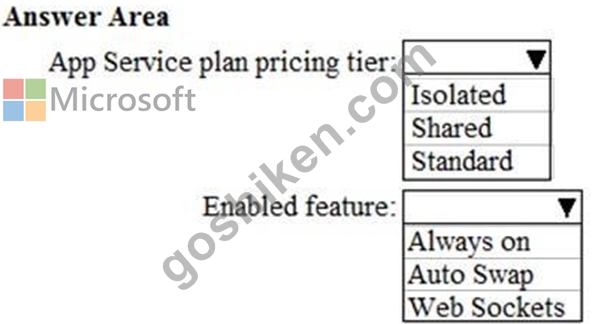
正解:
解説: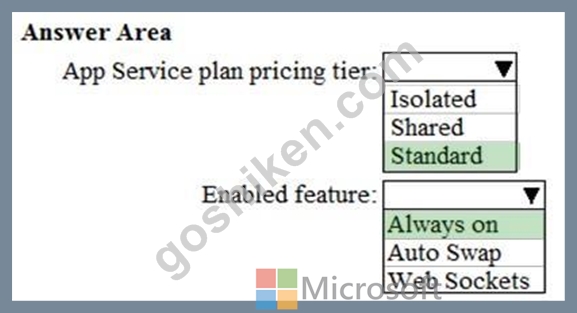
Explanation:
A newly developed API must be implemented as an Azure function named App2.
App2 will use a blob storage trigger. App2 must process new blobs immediately.
This requires "Always On".
The cost of App1 and App2 must be minimized
The Standard pricing tier is the cheapest tier that supports Always On.
質問 107
Note: This question is part of a series of questions that present the same scenario. Each question in the series contains a unique solution that might meet the stated goals. Some question sets might have more than one correct solution, while others might not have a correct solution.
After you answer a question in this section, you will NOT be able to return to it. As a result, these questions will not appear in the review screen.
You have an Azure subscription named Subscription1 that contains the resources shown in the following table.
VM1 connects to a virtual network named VNET2 by using a network interface named NIC1.
You need to create a new network interface named NIC2 for VM1.
Solution: You create NIC2 in RG2 and Central US.
Does this meet the goal?
- A. Yes
- B. No
正解: B
解説:
Explanation
The virtual machine you attach a network interface to and the virtual network you connect it to must exist in the same location, here West US, also referred to as a region.
References:
https://docs.microsoft.com/en-us/azure/virtual-network/virtual-network-network-interface
質問 108
You have an availability set named AS1 that contains three virtual machines named VM1, VM2, and VM3.
You attempt to reconfigure VM1 to use a larger size. The operation fails and you receive an allocation failure message.
You need to ensure that the resize operation succeeds.
Which three actions should you perform in sequence? To answer, move the appropriate actions from the list of actions to the answer area and arrange them in the correct order.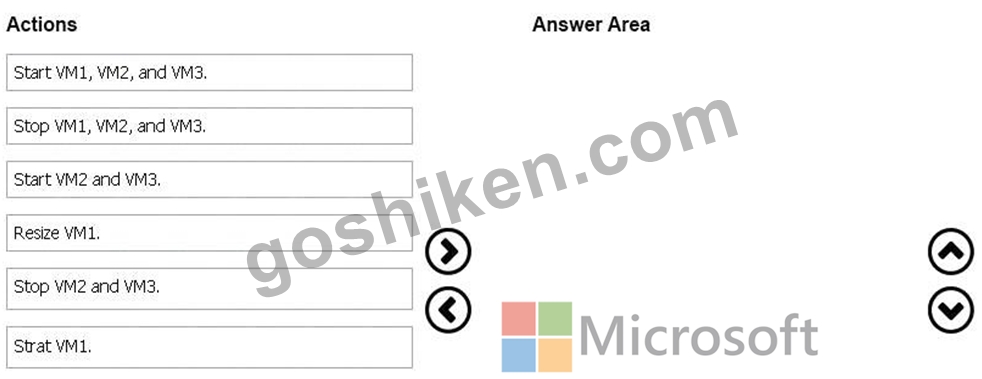
正解:
解説: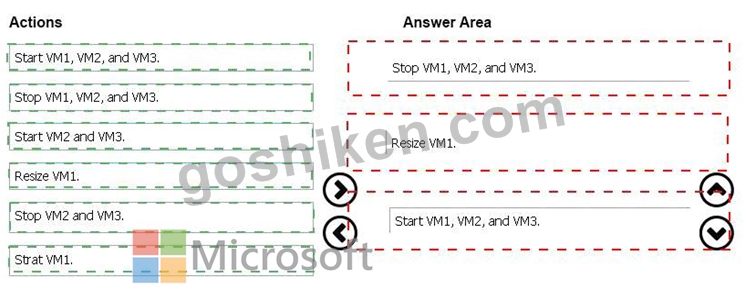
Explanation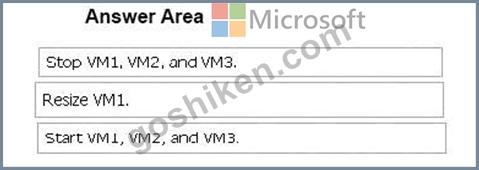
Action 1: Stop VM1, VM2 and VM3
If the VM you wish to resize is part of an availability set, then you must stop all VMs in the availability set before changing the size of any VM in the availability set. The reason all VMs in the availability set must be stopped before performing the resize operation to a size that requires different hardware is that all running VMs in the availability set must be using the same physical hardware cluster. Therefore, if a change of physical hardware cluster is required to change the VM size then all VMs must be first stopped and then restarted one-by-one to a different physical hardware clusters.
Action 2: Resize VM1
Action 3: Start VM1, VM2, and VM3
References:
https://azure.microsoft.com/es-es/blog/resize-virtual-machines/
質問 109
You have an on-premises network that you plan to connect to Azure by using a site-to-site VPN.
In Azure, you have an Azure virtual network named VNet1 that uses an address space of 10.0.0.0/16. VNet1 contains a subnet named Subnet1 that uses an address space of 10.0.0.0/24.
You need to create a site-to-site VPN to Azure.
Which four actions should you perform in sequence? To answer, move the appropriate actions from the list of actions to the answer area and arrange them in the correct order.
NOTE: More than one order of answer choices is correct. You will receive credit for any of the correct orders you select.
正解:
解説: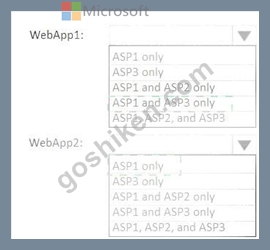
Explanation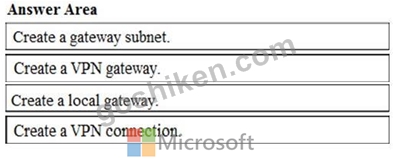
A Site-to-Site VPN gateway connection is used to connect your on-premises network to an Azure virtual network over an IPsec/IKE (IKEv1 or IKEv2) VPN tunnel. This type of connection requires a VPN device located on-premises that has an externally facing public IP address assigned to it. For more information about VPN gateways, see About VPN gateway.
1. Create a virtual network
You can create a VNet with the Resource Manager deployment model and the Azure portal
2. Create the gateway subnet :
The virtual network gateway uses specific subnet called the gateway subnet. The gateway subnet is part of the virtual network IP address range that you specify when configuring your virtual network. It contains the IP addresses that the virtual network gateway resources and services use.
3. Create the VPN gateway :
You create the virtual network gateway for your VNet. Creating a gateway can often take 45 minutes or more, depending on the selected gateway SKU.
4. Create the local network gateway:
The local network gateway typically refers to your on-premises location. You give the site a name by which Azure can refer to it, then specify the IP address of the on-premises VPN device to which you will create a connection. You also specify the IP address prefixes that will be routed through the VPN gateway to the VPN device. The address prefixes you specify are the prefixes located on your on-premises network. If your on-premises network changes or you need to change the public IP address for the VPN device, you can easily update the values later.
5. Configure your VPN device:
Site-to-Site connections to an on-premises network require a VPN device. In this step, you configure your VPN device. When configuring your VPN device, you need the following:
A shared key. This is the same shared key that you specify when creating your Site-to-Site VPN connection. In our examples, we use a basic shared key. We recommend that you generate a more complex key to use.
The Public IP address of your virtual network gateway. You can view the public IP address by using the Azure portal, PowerShell, or CLI. To find the Public IP address of your VPN gateway using the Azure portal, navigate to Virtual network gateways, then click the name of your gateway.
6. Create the VPN connection:
Create the Site-to-Site VPN connection between your virtual network gateway and your on-premises VPN device.
Reference:
https://docs.microsoft.com/en-us/azure/vpn-gateway/vpn-gateway-howto-site-to-site-resource-manager-portal
質問 110
You have an Azure subscription that contains the storage accounts shown in in the following table.
You plan to use AzCopy to copy a blob from container 1 directly to share1.
You need to identity which authentication method to use when you use AzCopy.
What should you identify for each account? To answer, drag the appropriate authentication methods to the correct accounts Each method may be used once, or not at all. You may need to drag the split bar between panes or scroll to view content.
NOTE: Each correct selection is worth one point.
正解:
解説:
質問 111
HOTSPOT
You have an Azure virtual machine that runs Windows Server 2019 and has the following configurations:
* Name: VM1
* Location: West US
* Connected to: VNET1
* Private IP address: 10.1.0.4
* Public IP addresses: 52.186.85.63
* DNS suffix in Windows Server: Adatum.com
You create the Azure DNS zones shown in the following table.
You need to identify which DNS zones you can link to VNET1 and the DNS zones to which VM1 can automatically register.
Which zones should you identify? To answer, select the appropriate options in the answer area.
NOTE: Each correct selection is worth one point.
Hot Area: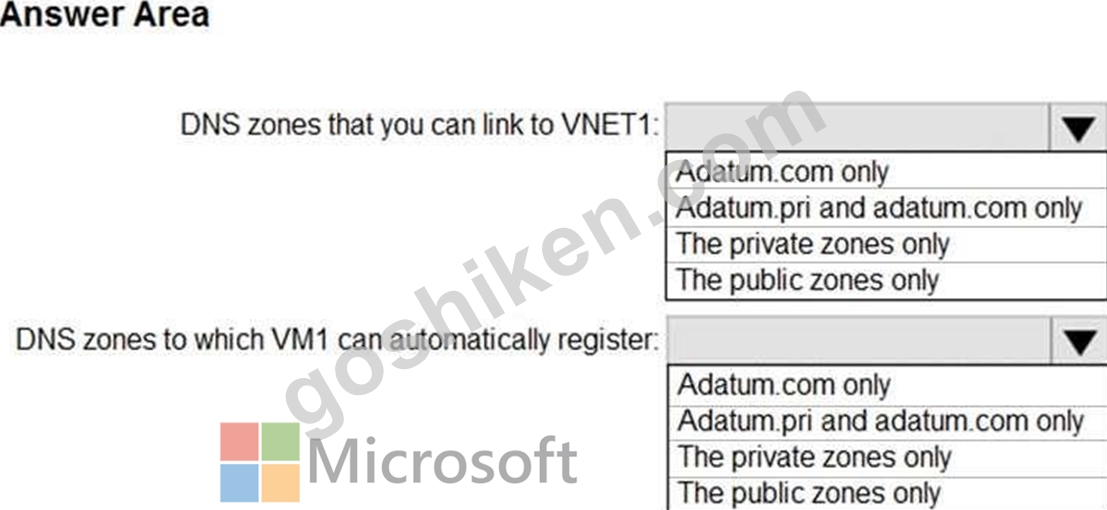
正解:
解説: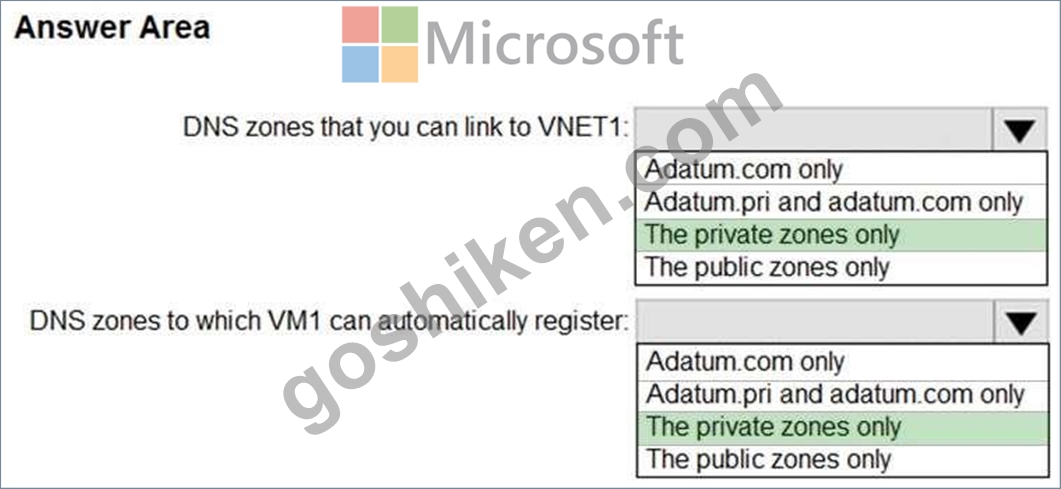
Section: [none]
Explanation/Reference:
https://docs.microsoft.com/en-us/azure/dns/private-dns-overview
質問 112
Note: This question is part of a series of questions that present the same scenario. Each question in the series contains a unique solution that might meet the stated goals. Some question sets might have more than one correct solution, while others might not have a correct solution.
After you answer a question in this section, you will NOT be able to return to it. As a result, these questions will not appear in the review screen.
You manage a virtual network named VNet1 that is hosted in the West US Azure region.
VNet1 hosts two virtual machines named VM1 and VM2 that run Windows Server.
You need to inspect all the network traffic from VM1 to VM2 for a period of three hours.
Solution: From Azure Network Watcher, you create a connection monitor.
Does this meet the goal?
- A. Yes
- B. No
正解: B
解説:
Network Watcher Connection Monitor enables you to configure and track connection reachability, latency, and network topology changes. It helps reduce the amount of time to detect connectivity problems. The returned results can provide insights into whether a connectivity problem is due to a platform or a user configuration problem. This is not used in cases where we need to inspect for all the network traffic from one vm to another vm.
On the other hand Network Watcher packet capture allows you to create capture sessions to track traffic to and from a virtual machine. So in this scenario we need to use Network Watcher packet capture
References:
https://azure.microsoft.com/en-in/updates/general-availability-azure-network-watcher-connection-monitor-in-all-public-regions/#:~:text=Network%20Watcher%20Connection%20Monitor%20helps,or%20a%20user%20configuration%20problem
https://docs.microsoft.com/en-us/azure/network-watcher/network-watcher-packet-capture-manage-portal
質問 113
You need to the appropriate sizes for the Azure virtual for Server2.
What should you do? To answer, select the appropriate options in the answer area.
NOTE: Each correct selection is worth one point.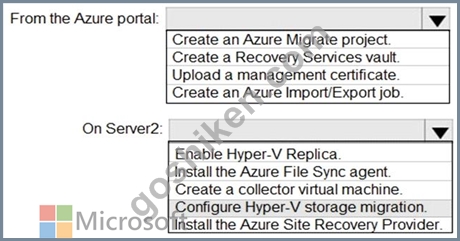
正解:
解説: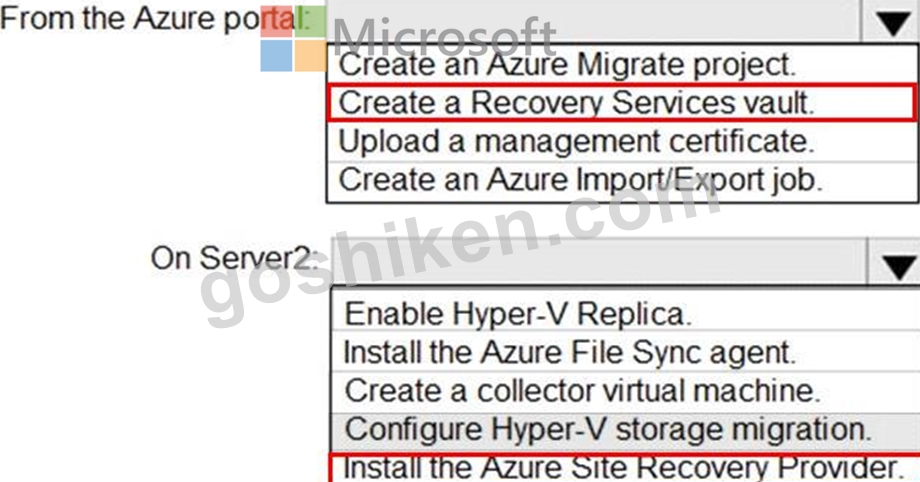
Explanation:
Box 1: Create a Recovery Services vault
Create a Recovery Services vault on the Azure Portal.
Box 2: Install the Azure Site Recovery Provider
Azure Site Recovery can be used to manage migration of on-premises machines to Azure.
Scenario: Migrate the virtual machines hosted on Server1 and Server2 to Azure.
Server2 has the Hyper-V host role.
References:
https://docs.microsoft.com/en-us/azure/site-recovery/migrate-tutorial-on-premises-azure
質問 114
You onboard 10 Azure virtual machines to Azure Automation State Configuration.
You need to use Azure Automation State Configuration to manage the ongoing consistency of the virtual machine configurations.
Which three actions should you perform in sequence? To answer, move the appropriate actions from the list of actions to the answer area and arrange them in the correct order.
NOTE: More than one order of answer choices is correct. You will receive credit for any of the correct orders you select.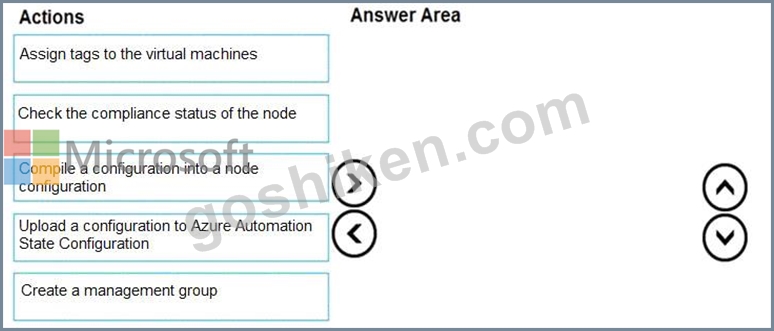
正解:
解説: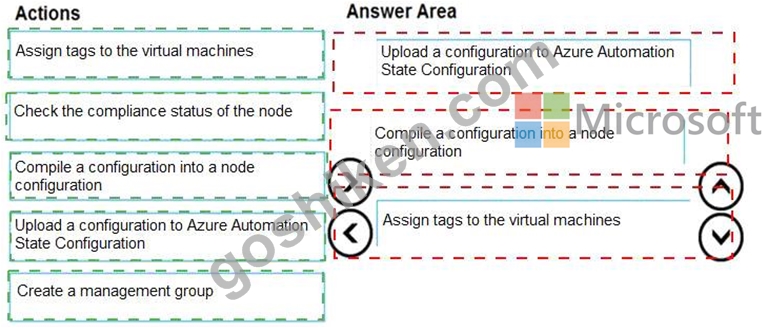
Explanation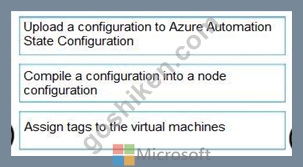
Step 1: Upload a configuration to Azure Automation State Configuration.
Import the configuration into the Automation account.
Step 2: Compile a configuration into a node configuration.
A DSC configuration defining that state must be compiled into one or more node configurations (MOF document), and placed on the Automation DSC Pull Server.
Step 3: Assign the node configuration
Step 4: Check the compliance status of the node
Each time Azure Automation State Configuration performs a consistency check on a managed node, the node sends a status report back to the pull server. You can view these reports on the page for that node.
On the blade for an individual report, you can see the following status information for the corresponding consistency check:
The report status - whether the node is "Compliant", the configuration "Failed", or the node is "Not Compliant" Reference:
https://docs.microsoft.com/en-us/azure/automation/automation-dsc-getting-started
質問 115
You have a resource group named RG1. RG1 contains an Azure Storage account named storageaccount1 and a virtual machine named VM1 that runs Windows Server 2016. Storageaccount1 contains the disk files for VM1. You apply a ReadOnly lock to RG1.
What can you do from the Azure portal?
- A. View the keys of storageaccount1.
- B. Upload a blob to storageaccount1.
- C. Start VM1.
- D. Generate an automation script for RG1.
正解: B
解説:
Applying locks can lead to unexpected results because some operations that don't seem to modify the resource actually require actions that are blocked by the lock. Locks are inherited to all of its resources if it applies on resource group level.
Upload a blob to storageaccount1 is possible if we have readonly lock on RG1 since we are trying to modify the data not resource properties.
When a R/O lock is put on a resource, you lock it's properties not the resource. So while a read only lock is present on a storage account(inherited from a resource group), a file can still be uploaded to the already existing container of a storage account.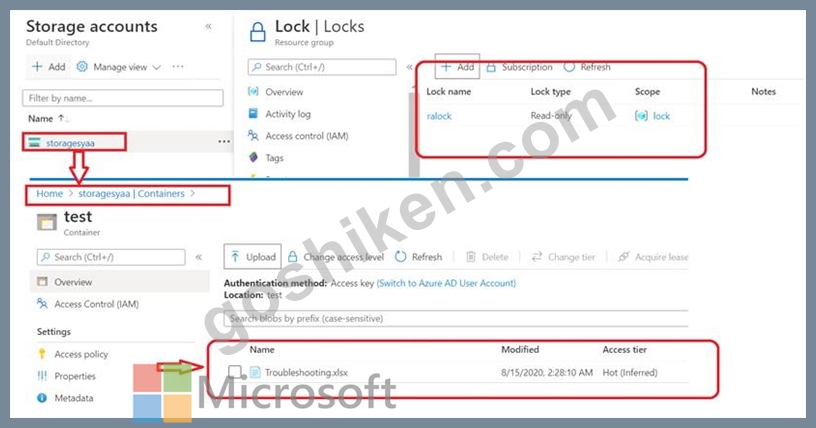
Incorrect Answers:
Generate an automation script for RG1 is NOT possible in read only mode.
A read-only lock on a storage account prevents all users from listing the keys. The list keys operation is handled through a POST request because the returned keys are available for write operations. When we tried to read the Access Key of the Storage Account , get the below message.
Access blocked The resource is locked Cannot access the data plane because of a read lock on the resource or its parent.
A read-only lock on a resource group that contains a virtual machine prevents all users from starting or restarting the virtual machine. These operations require a POST request.
References:
https://docs.microsoft.com/en-us/azure/azure-resource-manager/management/lock-resources
質問 116
You have an Azure subscription that contains an Azure Availability Set named WEBPROD-AS-USE2 as shown in the following exhibit.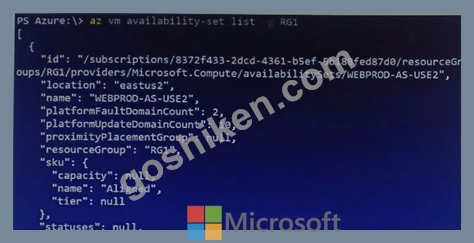

You add 14 virtual machines to WEBPROD-AS-USE2.
Use the drop-down menus to select the answer choice that completes each statement based on the information presented in the graphic.
NOTE: Each correct selection is worth one point.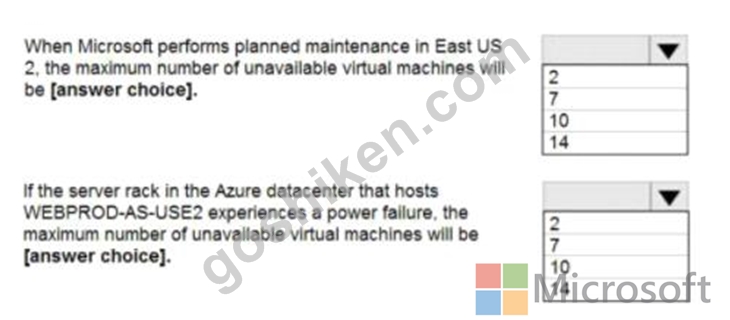
正解:
解説: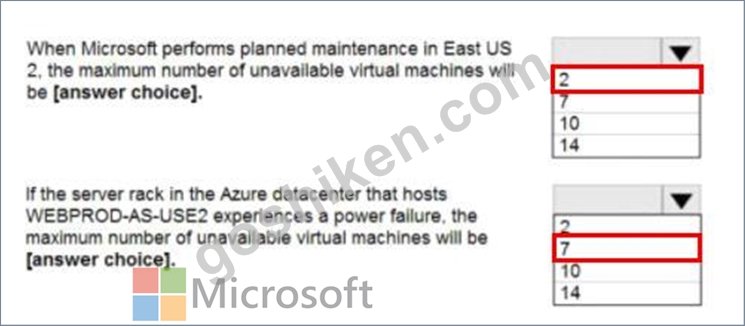
Box 1: 2
There are 10 update domains. The 14 VMs are shared across the 10 update domains so four update domains will have two VMs and six update domains will have one VM. Only one update domain is rebooted at a time.
Therefore, a maximum of two VMs will be offline.
Box 2: 7
There are 2 fault domains. The 14 VMs are shared across the 2 fault domains, so 7 VMs in each fault domain.
A rack failure will affect one fault domain so 7 VMs will be offline.
Reference:
https://docs.microsoft.com/en-us/azure/virtual-machines/windows/manage-availability
質問 117
You need to use Azure Automation State Configuration to manage the ongoing consistency of virtual machine configurations.
Which five actions should you perform in sequence? To answer, move the appropriate action from the list of actions to the answer area and arrange them in the correct order.
NOTE: More than one order of answer choices is correct. You will receive credit for any of the correct orders you select.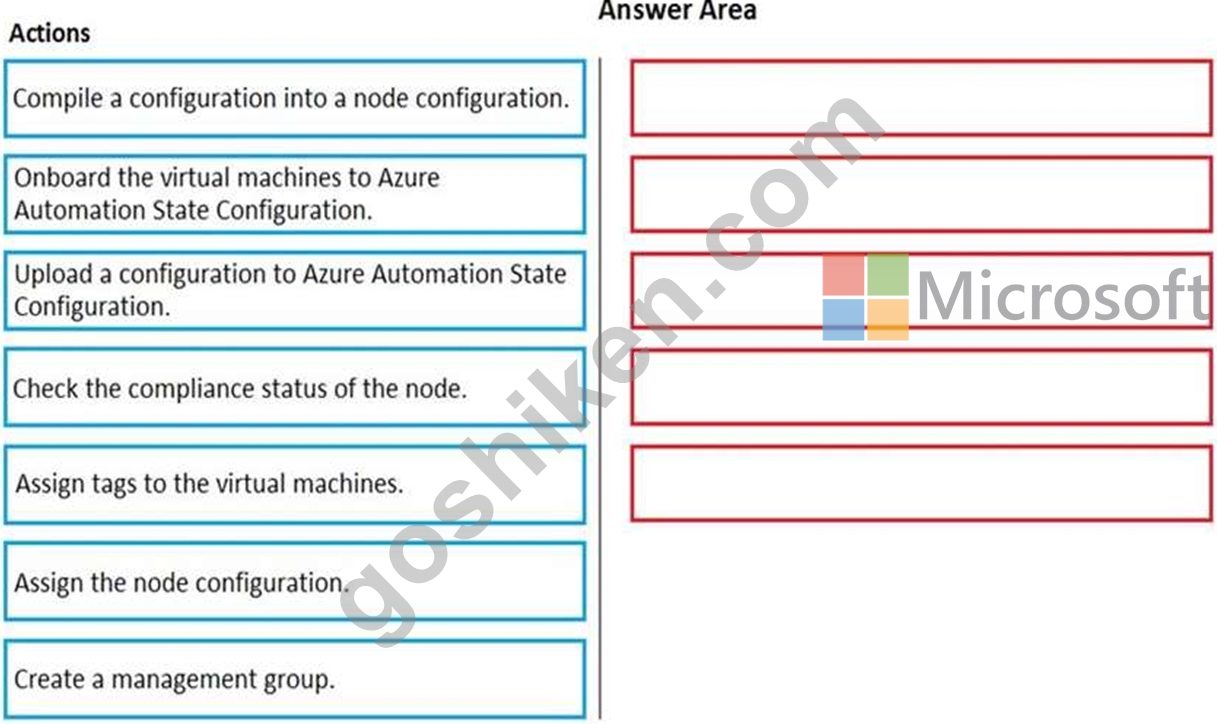
正解:
解説: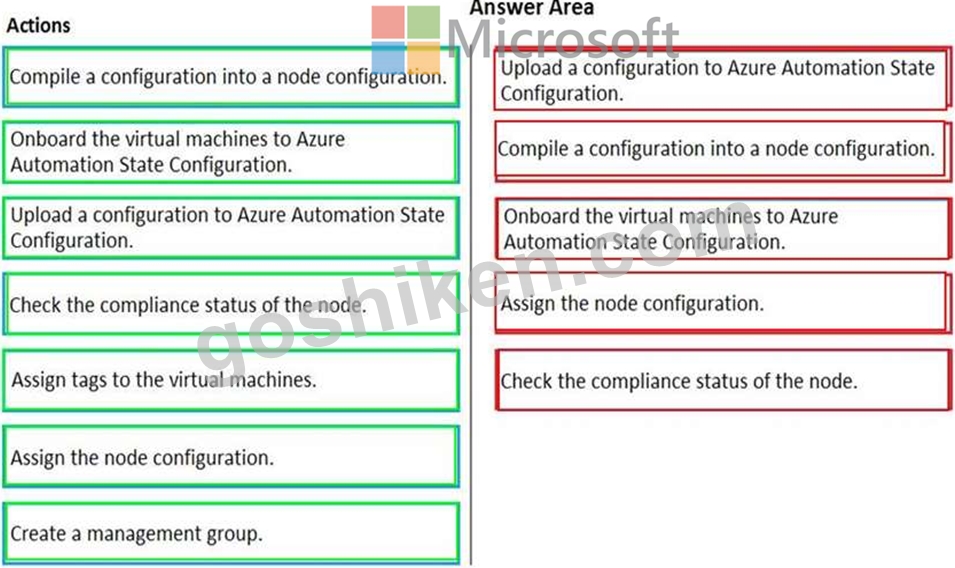
Reference:
https://docs.microsoft.com/en-us/azure/automation/automation-dsc-getting-started
質問 118
You have an Azure subscription that contains the following resources:
* a virtual network named VNet1
* a replication policy named ReplPolicy1
* a Recovery Services vault named Vault1
* an Azure Storage account named Storage1
You have an Amazon Web Services (AWS) EC2 virtual machine named VM1 that runs Windows Server 2019.
You need to migrate VM1 to VNet1 by using Azure Site Recovery.
Which three actions should you perform in sequence? To answer, move the appropriate actions from the list of actions to the answer area and arrange them in the correct order.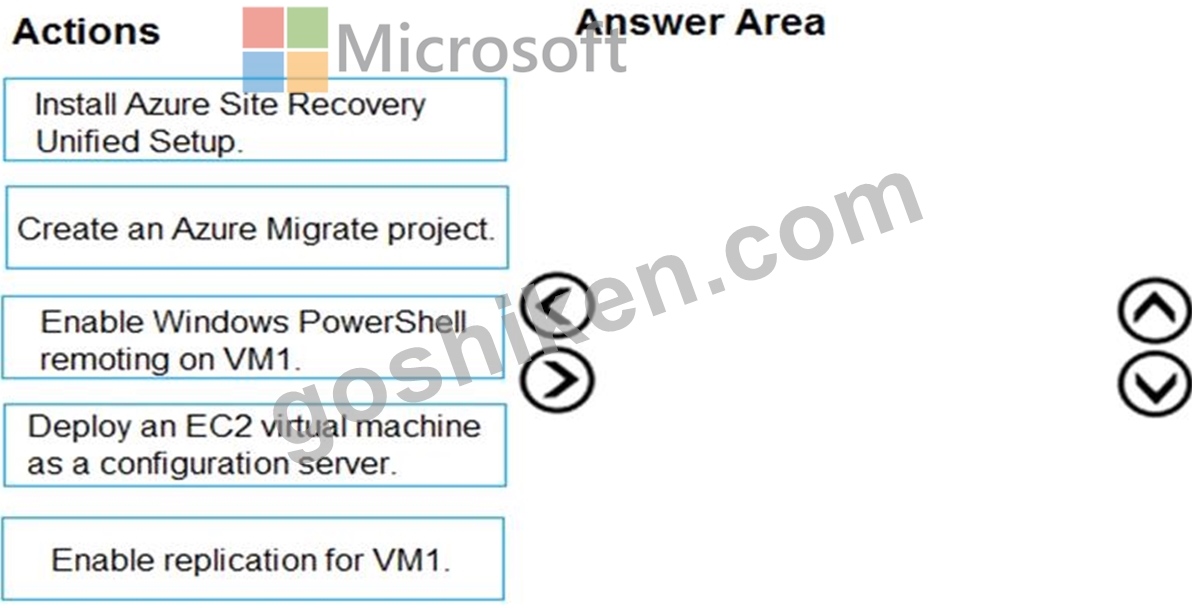
正解:
解説: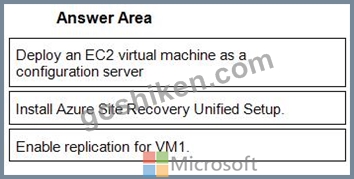
1 - Deploy an EC2 virtual machine as a configuration server
2 - Install Azure Site Recovery Unified Setup.
3 - Enable replication for VM1.
References:
https://docs.microsoft.com/en-us/azure/site-recovery/migrate-tutorial-aws-azure
質問 119
......
Microsoft AZ-104 認定試験の出題範囲:
| トピック | 出題範囲 |
|---|---|
| トピック 1 |
|
| トピック 2 |
|
| トピック 3 |
|
| トピック 4 |
|
| トピック 5 |
|
| トピック 6 |
|
| トピック 7 |
|
| トピック 8 |
|
| トピック 9 |
|
| トピック 10 |
|
| トピック 11 |
|
| トピック 12 |
|
AZ-104リアル無料試験問題と解答:https://www.goshiken.com/Microsoft/AZ-104-mondaishu.html
